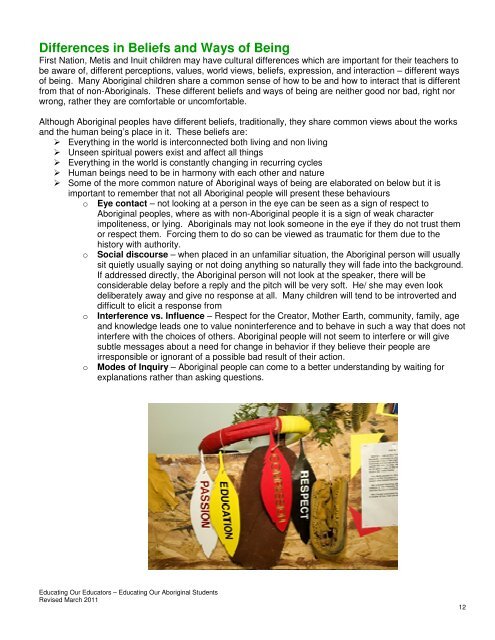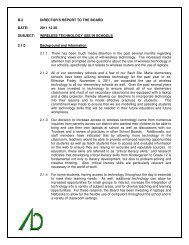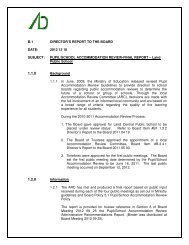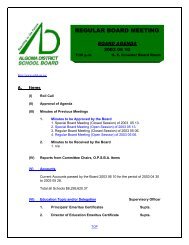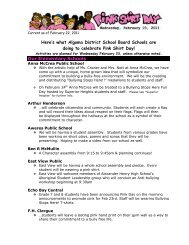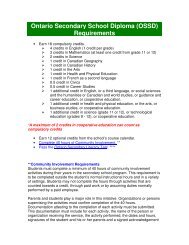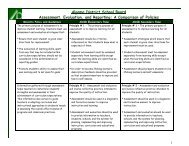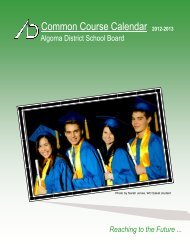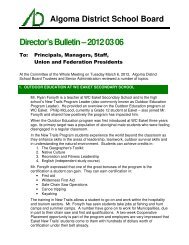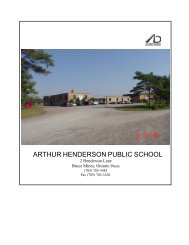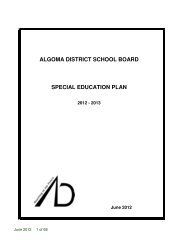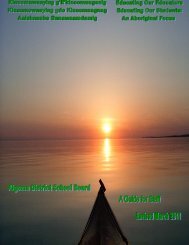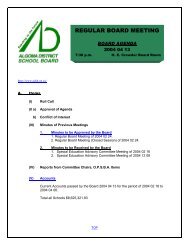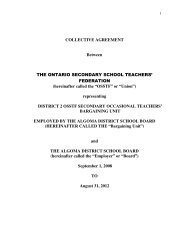Educating Our Educators Guide for Staff - Algoma District School ...
Educating Our Educators Guide for Staff - Algoma District School ...
Educating Our Educators Guide for Staff - Algoma District School ...
- No tags were found...
You also want an ePaper? Increase the reach of your titles
YUMPU automatically turns print PDFs into web optimized ePapers that Google loves.
Differences in Beliefs and Ways of BeingFirst Nation, Metis and Inuit children may have cultural differences which are important <strong>for</strong> their teachers tobe aware of, different perceptions, values, world views, beliefs, expression, and interaction – different waysof being. Many Aboriginal children share a common sense of how to be and how to interact that is differentfrom that of non-Aboriginals. These different beliefs and ways of being are neither good nor bad, right norwrong, rather they are com<strong>for</strong>table or uncom<strong>for</strong>table.Although Aboriginal peoples have different beliefs, traditionally, they share common views about the worksand the human being’s place in it. These beliefs are: Everything in the world is interconnected both living and non living Unseen spiritual powers exist and affect all things Everything in the world is constantly changing in recurring cycles Human beings need to be in harmony with each other and nature Some of the more common nature of Aboriginal ways of being are elaborated on below but it isimportant to remember that not all Aboriginal people will present these behaviourso Eye contact – not looking at a person in the eye can be seen as a sign of respect toAboriginal peoples, where as with non-Aboriginal people it is a sign of weak characterimpoliteness, or lying. Aboriginals may not look someone in the eye if they do not trust themor respect them. Forcing them to do so can be viewed as traumatic <strong>for</strong> them due to thehistory with authority.o Social discourse – when placed in an unfamiliar situation, the Aboriginal person will usuallysit quietly usually saying or not doing anything so naturally they will fade into the background.If addressed directly, the Aboriginal person will not look at the speaker, there will beconsiderable delay be<strong>for</strong>e a reply and the pitch will be very soft. He/ she may even lookdeliberately away and give no response at all. Many children will tend to be introverted anddifficult to elicit a response fromo Interference vs. Influence – Respect <strong>for</strong> the Creator, Mother Earth, community, family, ageand knowledge leads one to value noninterference and to behave in such a way that does notinterfere with the choices of others. Aboriginal people will not seem to interfere or will givesubtle messages about a need <strong>for</strong> change in behavior if they believe their people areirresponsible or ignorant of a possible bad result of their action.o Modes of Inquiry – Aboriginal people can come to a better understanding by waiting <strong>for</strong>explanations rather than asking questions.<strong>Educating</strong> <strong>Our</strong> <strong>Educators</strong> – <strong>Educating</strong> <strong>Our</strong> Aboriginal StudentsRevised March 201112


